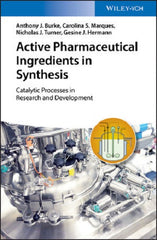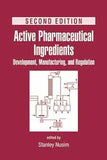Active Pharmaceutical Ingredients in Synthesis: Catalytic Processes in Research and Development Anthony J. Burke, Carolina Silva Marques, Nicholas J. Turner, Gesine J. Hermann
Active Pharmaceutical Ingredients in Synthesis: Catalytic Processes in Research and Development
Anthony J. Burke, PhD, is Professor at the University of Evora, and the coordinator of the organic and organometallic research line at the Centro de Química de Evora.
Carolina S. Marques, PhD, is working as a PostDoc in the Burke group.
Nicholas J. Turner, PhD, is Professor of Chemical Biology, Director of the Centre of Excellence in Biocatalysis (CoEBio3) and co-Director of SYNBIOCHEM.
Gesine J. Hermann, PhD, is a research and business consultant for ChiraTecnics, Portugal.
October 2018 382 Pages
DESCRIPTION
This book demonstrates the importance of efficient catalytic transformations for producing pharmaceutically active molecules. It presents the key catalytic reactions and the most efficient catalytic processes, including their significant advantages over compared previous methods. It also places a strong emphasis on asymmetric catalytic reactions, process intensification (PI), sustainability and waste mitigation, continuous manufacturing processes as enshrined by continuous flow catalysis, and supported catalysis.
Active Pharmaceutical Ingredients in Synthesis: Catalytic Processes in Research and Development offers chapters covering: Catalysis and Prerequisites for the Modern Pharmaceutial Industry Landscape; Catalytic Process Design - The Industrial Perspective; Hydrogenation, Hydroformylation and Other Reductions; Oxidation; ; Catalytic Addition Reactions; Catalytic Cross-Coupling Reactions; Catalytic Metathesis Reactions; Catalytic Cycloaddition Reactions: Coming Full-Circle; Catalytic Cyclopropanation Reactions; Catalytic C-H insertion Reactions; Phase Transfer Catalysis; and Biocatalysis.
-Provides the reader with an updated clear view of the current state of the challenging field of catalysis for API production
-Focuses on the application of catalytic methods for the synthesis of known APIs
-Presents every key reaction, including Diels-Alder, CH Insertions, Metal-catalytic coupling-reactions, and many more
-Includes recent patent literature for completeness
Covering a topic of great interest for synthetic chemists and R&D researchers in the pharmaceutical industry, Active Pharmaceutical Ingredients in Synthesis: Catalytic Processes in Research and Development is a must-read for every synthetic chemist working with APIs.
TABLE OF CONTENTS
Foreword xi
Preface xiii
Abbreviations xvii
1 Catalysis and Prerequisites for the Modern Pharmaceutical Industry Landscape 1
1.1 Introduction 1
1.2 Key Historical Moments in Catalysis Development 2
1.3 Key Historical Developments in Catalysis for API Synthesis: Including Catalytic Asymmetric Synthesis 11
1.4 Catalytic Synthesis of APIs in the Twenty‐First Century: New Developments, Paradigm Shifts, and Future Challenges 20
1.5 Conclusions 26
References 26
2 Catalytic Process Design: The Industrial Perspective 31
2.1 Introduction 31
2.2 Process Design 32
2.2.1 Heterogeneous and Homogeneous Catalysts 32
2.2.2 Product Safety and Regulatory Requirements 36
2.2.3 Control of Residual Metals 37
2.2.3.1 Filtration and Adsorption 38
2.2.3.2 Extraction and Scavenging 38
2.2.3.3 Organic Solvent Nanofiltration (OSN) 41
2.2.4 Design of Experiment (DoE) 43
2.2.5 Catalyst Recycling 45
2.2.6 Scalability, Safety, and Environmental Aspects 46
2.3 Examples of Homogeneous and Heterogeneous Catalytic Reactions in API Manufacture 49
2.3.1 Batch Operations 49
2.3.2 Continuous‐Flow Operations 63
2.4 Conclusions 67
References 68
3 Hydrogenation, Hydroformylation, and Other Reductions 75
3.1 Introduction 75
3.2 Hydrogenation 75
3.2.1 Hydrogenation of Alkenes 77
3.2.1.1 Enamides 77
3.2.2 Hydrogenation of Carbonyl Groups 84
3.2.3 Hydrogenation of Imines 87
3.3 Transfer Hydrogenation 88
3.3.1 On Ketones 88
3.3.2 On Imines 92
3.4 Reductions with Oxazaborolidine Catalytic Systems 94
3.5 Hydroformylation 96
3.6 Reductions with Organocatalysts 103
3.7 Other Catalytic Reductions 104
3.7.1 Reduction of Nitro Units 104
3.7.2 Other Reductions 107
3.8 Conclusions 107
References 108
4 Oxidation: Nobel Prize Chemistry Catalysis 113
4.1 Introduction 113
4.2 Olefin Epoxidation 113
4.2.1 Metal‐based Electrophilic Methods 113
4.2.1.1 The Sharpless–Katsuki Asymmetric Epoxidation 113
4.2.1.2 The Jacobsen–Katsuki Asymmetric Epoxidation 116
4.2.2 Nucleophilic Methods 119
4.2.2.1 Nucleophilic Methods with Hydrogen Peroxide 119
4.2.3 Organocatalytic Methods 119
4.3 Olefin Dihydroxylation 121
4.4 Olefin Aminohydroxylation 125
4.5 Sulfur Oxidation 127
4.5.1 Synthesis of Sulfoxides – Use of Titanium, Molybdenum, and Vanadium Catalysts 127
4.5.2 Synthesis of Sulfones – Use of Tungsten Catalysts 132
4.6 Catalytic Oxidation of Carbonyls – Cu/Nitroxyl and Nitroxyl/NOx Catalytic Systems 133
4.7 Oxidative Dehydrogenations (ODs) 139
4.8 Conclusions 141
References 142
5 Catalytic Addition Reactions 147
5.1 Introduction 147
5.2 1,2‐Additions 148
5.3 1,4‐Additions 158
5.4 Conclusions 170
References 171
6 Catalytic Cross‐Coupling Reactions – Nobel Prize Catalysis 175
6.1 Introduction 175
6.2 Heck–Mizoroki Reaction 176
6.3 The Suzuki–Miyaura Reaction 195
6.4 The Buchwald–Hartwig Reaction 210
6.5 The Sonogashira–Hagihara Reaction 224
6.6 The Allylic Substitution Reaction 234
6.7 C–H Activation Processes 239
6.8 Oxidative C─C Bond Formation 248
6.9 Conclusions 251
References 251
7 Catalytic Metathesis Reactions: Nobel Prize Catalysis 259
7.1 Introduction 259
7.2 Metathesis with Ru‐Based Catalysts 264
7.3 Mo‐Based Metathesis 283
7.4 Conclusions 286
References 286
8 Catalytic Cycloaddition Reactions: Coming Full Circle 291
8.1 Introduction 291
8.2 The “Classical” Catalytic Diels–Alder Reaction – Closing the Circle 291
8.3 The Catalytic Hetero‐Diels–Alder (hDA) Reaction 299
8.4 The Catalytic [3+2] Cycloaddition Reaction 302
8.4.1 1,3‐Dipolar Azomethine Ylide Cycloadditions 302
8.4.2 [3+2] Cycloadditions with Carbonyl Ylides 307
8.4.3 The Azide Catalytic [3+2] Cycloaddition Reaction – The Dawn of Click Chemistry 308
8.5 Other Cycloaddition Reactions 312
8.5.1 [2+2] Cycloaddition 312
8.5.2 [2+2+2] Cycloaddition 313
8.5.3 [5+2] Cycloaddition 315
8.6 Conclusions 316
References 317
9 Catalytic Cyclopropanation Reactions 321
9.1 Introduction 321
9.2 Metal‐Catalyzed Processes 323
9.3 Conclusions 338
References 338
10 Catalytic C–H Insertion Reactions 341
10.1 Introduction 341
10.2 Metal‐Catalyzed Processes 342
10.3 Conclusions 356
References 357
11 Phase‐Transfer Catalysis 359
11.1 Introduction 359
11.2 Achiral Phase‐Transfer Catalysis 360
11.3 Asymmetric Phase‐Transfer Catalysis 369
11.4 Conclusions 382
References 382
12 Biocatalysis 387
12.1 Introduction 387
12.2 Hydrolysis and Reverse Hydrolysis 388
12.3 Reduction 394
12.4 Oxidation 399
12.5 C─X Bond Formation 402
12.6 Conclusions 411
References 411
Index 415

















